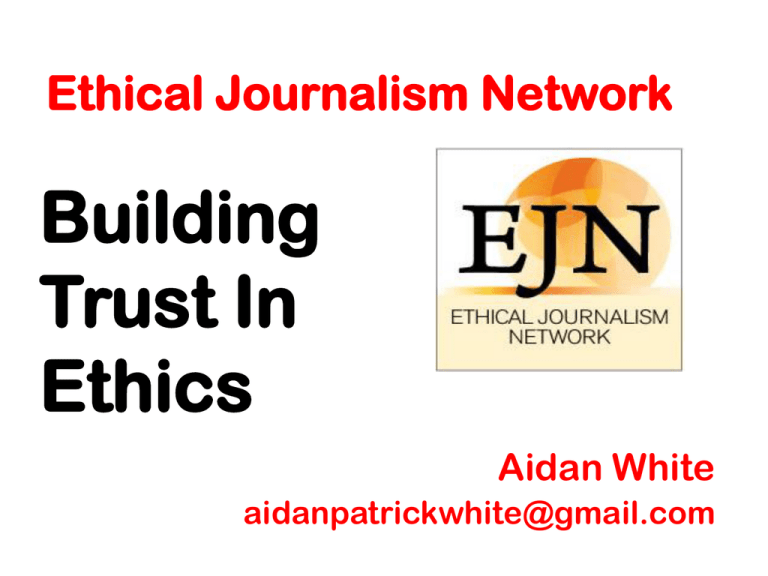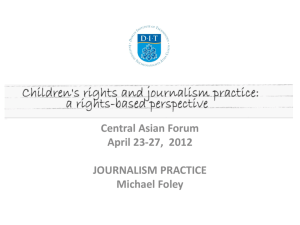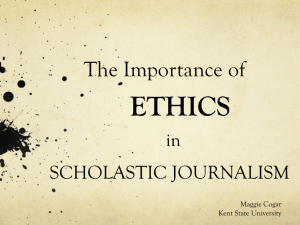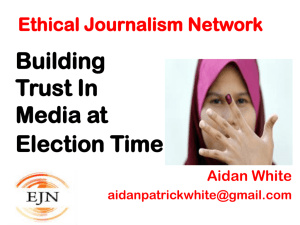Making Ethics Work Presentation November 2013
advertisement

Ethical Journalism Network Building Trust In Ethics Aidan White aidanpatrickwhite@gmail.com Ethics and Journalism Journalism’s conventions and standards are set out in codes. There are more than 400 codes agreed at national and global level. http://rjionline.org/AS-Codes-ofEthics Getting Started • The first stage is a Mission Statement: who we are, what is our purpose? • Then we adopt a Code of Standards : our values and commitment to standards • Then we prepare editorial guidelines :these translate the code into practice of journalism Codes are short – guidelines are detailed, practical, detailed and based on experience Traditional Values in Practice Media have developed models: The BBC http://www.bbc.co.uk/editorialguidelines/ Associated Press http://www.ap.org/company/news-values GEO TV Pakistan http://geo.tv/asool/ Ethical Contracts: Pakistan Example A) GEO Manifesto - Our values, goals and declared biases B) Best Practices Guidelines on Geo Manifesto : A document defining operational work across the company. C) TeamGEO Ethical Journalism Handbook : Ethics guidance for journalists. D) Monitoring and Implementing Procedure: How we will monitor and implement the above Ethical Contracts: Employment Obligations • Writing Code of Conduct into Contract of employment for Journalists • Including Clause of Conscience • Ensure Internal Culture of Attachment to Company Values • Self-Reporting on Standards as a Business strategy – Internal Ethical Auditing Ethical Audit : Internal Reporting Our Commitment to ethics and good governance • Mission statement , codes of conduct • governance rules (transparency, avoiding conflicts of interest) • engagement with external regulators (press council, etc) • Recognition and reward for quality work (prizes, etc) • Promoting integrity through co-operation between different sections of the company (commercial, marketing and editorial) How much journalism we have produced • Numbers of editorial columns, contributions from external sources (commissioned and uncommissioned), and numbers of contributors on all platforms (including online sections), • Examples of holding power to account – business, politics, sports cultural life, etc. • Examples of issues raised and debates on important topics How company protects editorial independence • Separation of commercial activities and editorial activities • Independence of the editor in chief : statement of editor on challenges and opportunities • Obligation of journalists to respect ethical codes How Company deals with complaints and concerns of audience • Internal systems for dealing with complaints • Numbers of complaints received internally. How many resolved amicably, how many legal cases, how many complaints to the press council or industry regulator? • External systems for dealing with complaints (press council, etc.) • Actions for engaging with the audience and readers. Safety and Protection of Journalists and Media Staff • Provision of training and awarenessraising for reporting in danger zones • First aid training • Availability of medical insurance and life insurance • Co-operation with industry initiatives to improve safety Management and ownership of the company • Status, name and address of the company, its range of activities, financial holdings • Board of Directors, Structure of management • Rules of internal governance • Report on company actions to combat corruption and conflicts of interest • Income received from state and external sources • Details of membership in groups such as industry associations at national/international advocacy Information on economic performance • Circulation figures and audience reach • Details of the company’s financial status and reports as provided to national authorities as required by law. • A commentary on financial trends and market conditions. Industrial relations, labour standards and training activity • Respect for national and international labour standards including trade union recognition, collective bargaining and gender equality • What we have done to improve journalistic skills and other training for staff • Numbers of full time, part-time and freelance staff • Actions to promote diversity in staff employment Company objectives and targets • Set out targets – editorially and commercially – for the company • Assess successes and failures • Highlight specific projects and programmes Industry trends • Challenges and risks in the next year • Opportunities and potential for development Building the Business of Journalism Through Transparency Accountability Review and Reflection Build Trust






